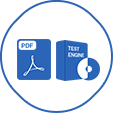Last Update 6 hours ago Total Questions : 64
The SAP Certified Associate - SAP Generative AI Developer content is now fully updated, with all current exam questions added 6 hours ago. Deciding to include C_AIG_2412 practice exam questions in your study plan goes far beyond basic test preparation.
You'll find that our C_AIG_2412 exam questions frequently feature detailed scenarios and practical problem-solving exercises that directly mirror industry challenges. Engaging with these C_AIG_2412 sample sets allows you to effectively manage your time and pace yourself, giving you the ability to finish any SAP Certified Associate - SAP Generative AI Developer practice test comfortably within the allotted time.
Why is generative Al gaining significant attention and investment in the current business landscape? Note: There are 2 correct answers to this question.
What is the purpose of splitting documents into smaller overlapping chunks in a RAG system?
How does SAP ensure the enterprise-readiness of its Al solutions?
What are the benefits of SAP's generative Al hub? Note: There are 2 correct answers to this question.
What is a Large Language Model (LLM)?
How does the Al API support SAP AI scenarios? Note: There are 2 correct answers to this question.
What capabilities does the Exploration and Development feature of the generative Al hub provide? Note: There are 2 correct answers to this question.

